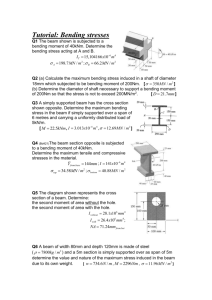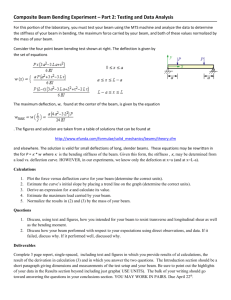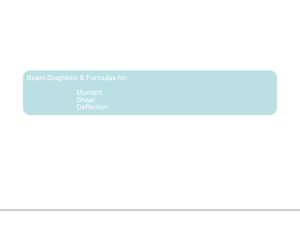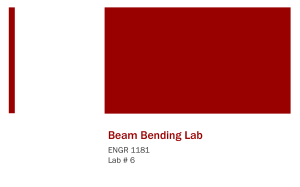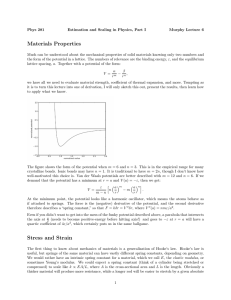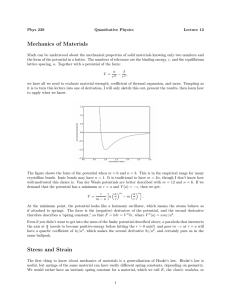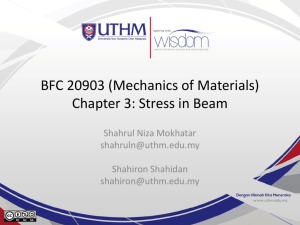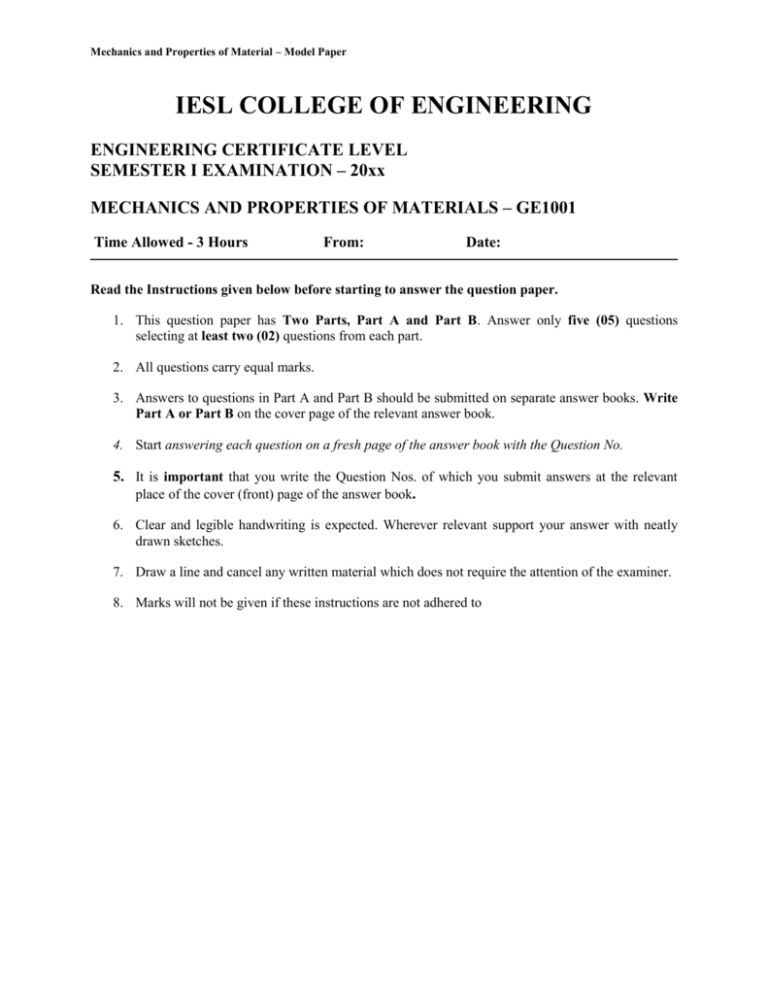
Mechanics and Properties of Material – Model Paper
IESL COLLEGE OF ENGINEERING
ENGINEERING CERTIFICATE LEVEL
SEMESTER I EXAMINATION – 20xx
MECHANICS AND PROPERTIES OF MATERIALS – GE1001
Time Allowed - 3 Hours
From:
Date:
Read the Instructions given below before starting to answer the question paper.
1. This question paper has Two Parts, Part A and Part B. Answer only five (05) questions
selecting at least two (02) questions from each part.
2. All questions carry equal marks.
3. Answers to questions in Part A and Part B should be submitted on separate answer books. Write
Part A or Part B on the cover page of the relevant answer book.
4. Start answering each question on a fresh page of the answer book with the Question No.
5. It is important that you write the Question Nos. of which you submit answers at the relevant
place of the cover (front) page of the answer book.
6. Clear and legible handwriting is expected. Wherever relevant support your answer with neatly
drawn sketches.
7. Draw a line and cancel any written material which does not require the attention of the examiner.
8. Marks will not be given if these instructions are not adhered to
PART A
Question 1
a.
Briefly explain the following Mechanical properties.
(i) Strength
(ii) Ductility
(iii) Elasticity
(iv) Plasticity
(v) Hardness
b.
During a tensile test on a specimen of a non-ferrous alloy the following results
were observed on the experimental set up.
Load (N)
0
2,000
4,000
6,000
8,000
10,000
11,000
12,000
13,000
Extension
(mm)
0
0.06
0.11
0.17
0.23
0.29
0.33
0.48
0.58
(N)
Original diameter and the final diameter of the specimen are 14.0 mm and
9.0 mm respectively. Gauge length is 50 mm.
(i)
Plot the Load versus Extension curve on a graph paper.
(ii)
Find the following with the help of the load versus extension curve.
Yield strength
Modulus of Elasticity
0.2% proof stress
Tensile strength at the maximum load
The percentage reduction in cross sectional area of the specimen.
Question 2
b.
Draw the following crystallographic plane and the direction in a cubic unit cell.
(i) ( 3 2 0)
(ii) [ 3 2 0]
c.
Copper has a Face Centered Cubic (FCC) structure and an atomic radius
0.128nm. Calculate the linear density of copper atoms in the [110] direction.
Page 2 of 6
d.
Identify the Miller indices of the plane and the direction given in the Fig. Q(2)
below.
Z
Fig. 5 plane
(a) and
direction (c)
1/3
Y
1/3
X
Figure Q(2)
Question 3
a.
Sketch and label a typical creep curve (strain vs time) for a hypothetical material
and discuss the behavior of the material during three stages associated with the
graph.
b.
Explain how the steady state creep rate can be determine from the graph.
c.
A shaft of 45 mm diameter is to carry a load of 25 kN at a temperature of 2000C.
The material’s steady state creep rate follows the Norton equation given by,
dε/dt = C σn, where C = 4.5x10-4 and n =3.2 ( when stress is given in MPa and
strain rate is in m/m/hr)
If the allowable strain is 0.25%, determine the useful life expectancy of the shaft.
Question 4
For a plain carbon steel containing 0.4 wt% of carbon, which has been heated to
1000o C uniformly and then cooled down slowly, answer the following questions
using the phase diagram given in Fig.Q(4).
Page 3 of 6
Figure Q(4)
a.
What phases would be present at 950oC, 760oC and 650oC?
b.
What proportions of ferrite and austenite would be present at 750oC?
c.
d.
Compute the mass fraction of pro-eutectoid ferrite and pearlite in the sample at
650oC (assume it was not kept too long at this temperature)
Compute the mass fraction of total ferrite (α) and cementite (Fe3C) phases.
PART B
Question 5
a. Prove the relationship
where
𝑀
𝐼
=
𝜎
𝑦
=
𝐸
𝑅
applicable to bending of beams,
M = Bending moment, I = Moment of inertia,
σ = Bending stress at
a distance y from the neutral axis, E = Young’s Modulus, and R =
Radius of curvature of the beam
Page 4 of 6
b.
100 mm
50 mm
Figure.Q5
200 mm
50 mm
X
C.G
X
50 mm
200 mm
Figure.Q5 shows a section of a steel beam with un-symmetrical ‘I’ section about X-X axis,
which passes through the centre of area of the section. If the maximum bending stress in
the beam section is not to exceed 50 MPa, find the bending moment, which the beam can
resist.
Sketch the bending stress distribution across the section.
Question 6
a.
Obtain the relationship between the torque (T) and the twist per unit length (θ/L) for a
solid circular shaft of diameter (d) and modulus of rigidity (G). State all assumptions
made.
b. Determine the diameter of the solid shaft which is capable of transmitting 200 kW at
150 rpm. The maximum shear stress should not exceed 25 N/mm2 and twist should not
be more than 10 over a shaft length of 2m.
Assume the modulus of rigidity of the material G = 0.80 N/mm2.
Question 7
a.
What is the principle of the superposition? Explain its use with an application.
b.
What are the different types of loads that can be applied on beams?
c.
A beam ABCD simply supported at A and D has 4 m length. It overhangs by 1 m to
the left from the support at A and carries uniformly distributed load with intensity of
3 kN/m over a 1 m length from A and 5 kN concentrated load at C as shown in
Figure Q 7.
Page 5 of 6
5 kN
3 kN/m
A
B
1m
D
C
1m
2m
R
R
Figure Q7
Draw the shear force and bending moment diagrams for the beam and locate the point
of contraflexture.
Question 8
a.
Derive expressions for the deflection and slope of a cantilevered beam of flexural
stiffness EI and length L carrying a vertical concentrated load W at its free end.
b.
A vertical load of 12 kN is applied downward at the free end of a horizontal
cantilevered beam, of which flexural stiffness is 12x1012 Nmm2 and length 3.2 m.
i)
What is the vertical force that should be applied at a distance of 2 m from the
fixed end of the beam in the upward direction to bring the beam’s free end back to
its original position (zero deflection)?
ii) Calculate the resulting deflection and slope of the beam at the position where the
upward force is applied.
Neglect the weight of the beam.
All Rights Reserved.
Additional Instructions:
1. This question paper has two parts always and one part covers Mechanics of Material and
the other Properties of Material. Answer questions by selecting the questions as in the
instructions given at the beginning of the question paper.
2. Do not expect to have in the examination question paper the same topics which are covered
in this model question paper. The model question paper exemplifies only the format, degree
of difficulty and style of questions.
Page 6 of 6


